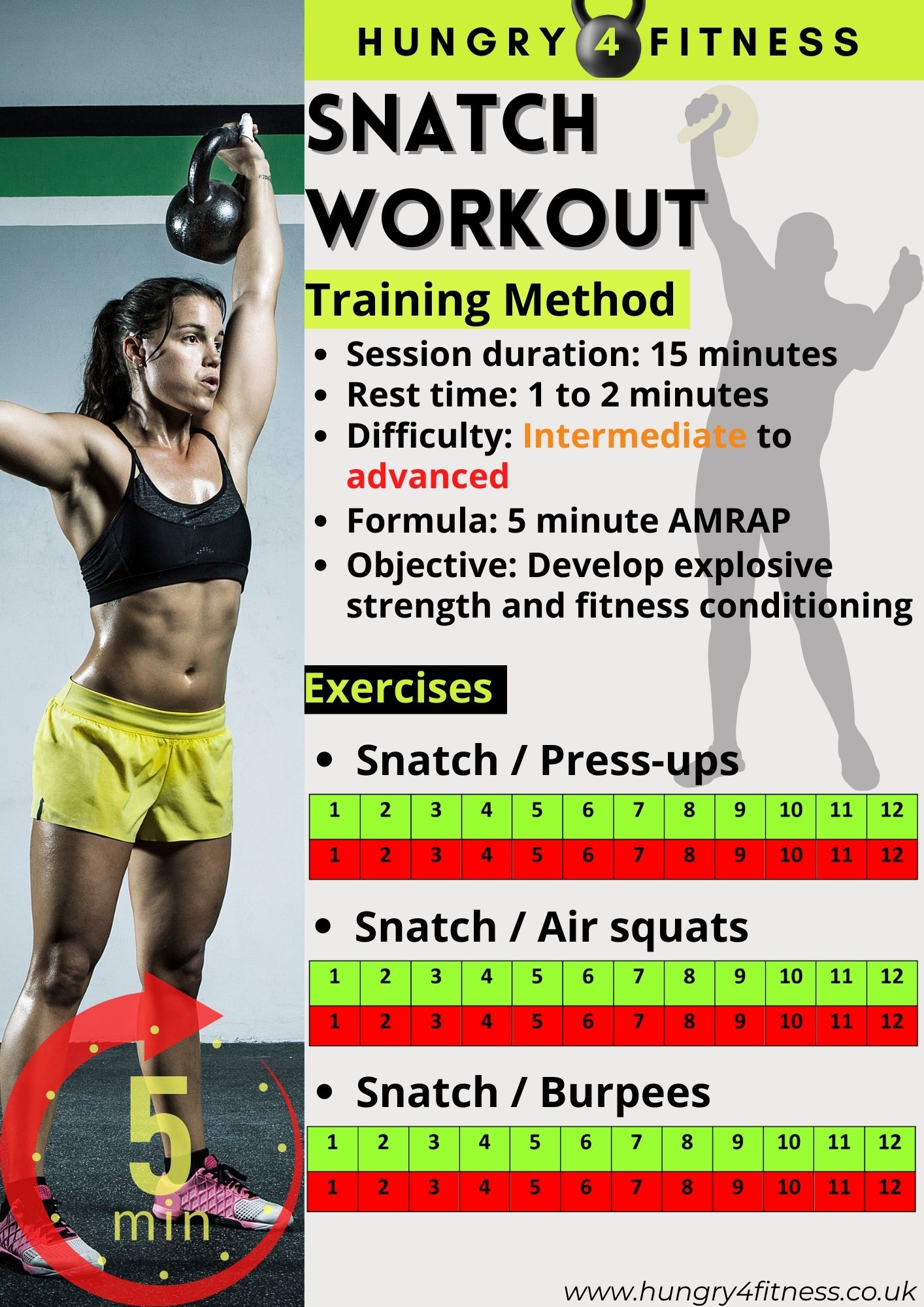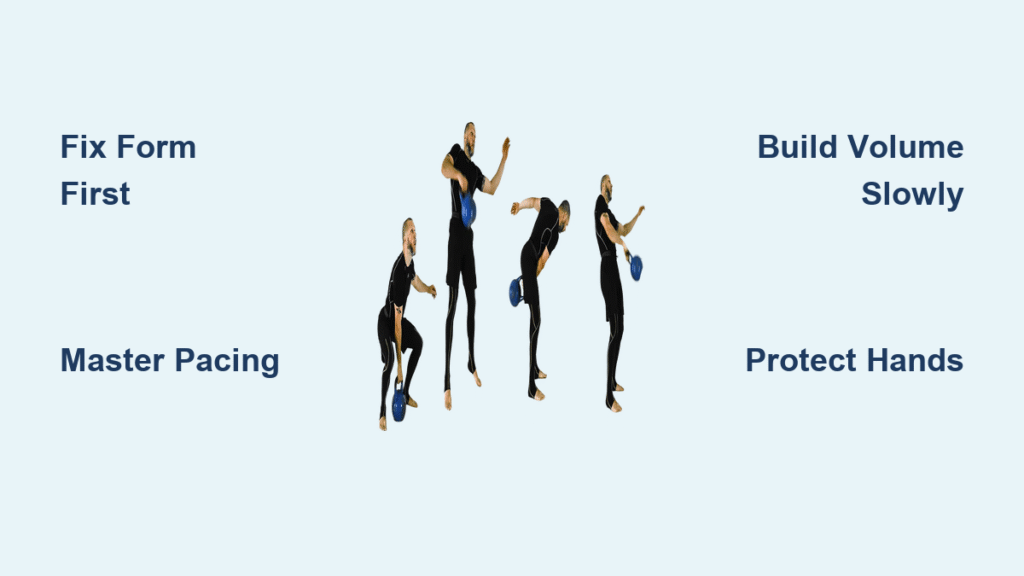Your heart pounds as you grip the kettlebell handle, sweat dripping onto the floor while 200 explosive snatches loom ahead. This isn’t just another exercise—it’s the Secret Service’s metabolic inferno that burns 20+ calories per minute while forging bulletproof shoulders and hip power. The kettlebell snatch workout transforms a single iron cannonball into your complete conditioning system, delivering tactical-grade fitness in your living room without joint-jarring impact. Whether you’re chasing the legendary 200-rep benchmark or building mountain-ready stamina, these protocols deliver transferable athletic gains that outperform traditional cardio.
Mastering this “Tsar of kettlebell lifts” unlocks total-body transformation: stronger posterior chain, ironclad grip endurance, and lung-searing conditioning that transfers directly to obstacle racing, mountaineering, or combat sports. Forget endless treadmill sessions—just 10 minutes of snatches torches 202 calories (versus 99 from 10 minutes of running) while building explosive power. Prepare to discover exactly how to build from your first clean snatch to crushing elite military standards through proven programming.
Fix Your Kettlebell Snatch Form Immediately

Wrist pain or inconsistent lockouts? Your technique breakdown starts before the bell even leaves the ground. The snatch must flow as one explosive motion: hip-driven swing power transitioning seamlessly into overhead lockout without pauses or corrections. Fix these critical errors before adding volume.
Hand Insertion Timing Cues
Grip the handle corner—not center—to reduce wrist impact during turnover. As the bell rises past chest height, aggressively “punch the sky” with your fist while rotating the bell around your wrist. The bell should land softly against your forearm like a feather, not slam down. If you’re bruising your wrist, you’re late on hand insertion; practice high pulls to chest height first.
Overhead Stability Fixes
Shoulder shrugging during lockout reveals weak scapular control—immediately pack your shoulder down by engaging your lats. Lumbar hyperextension means your core disengaged during the hip snap; brace your abs like preparing for a punch. Forward head position compromises balance—keep your eyes fixed on a spot 6 feet ahead throughout the movement.
Swing-to-Snatch Transition Drill
Stand with feet shoulder-width apart, kettlebell one foot in front. Hike the bell deep between your legs like a football snap, then drive through your hips to accelerate the bell upward. At the top of the swing, pull your elbow high toward the ceiling and punch through to lockout. Reverse slowly into the backswing to reset. Perform 3 sets of 5 reps daily until the motion becomes automatic.
Build Snatch Readiness in 6 Weeks

Skipping foundational work guarantees injury. Before attempting high-volume snatch protocols, you must prove readiness through these non-negotiable prerequisites—all achievable within 6 weeks of focused prep.
Movement Prerequisites Checklist
- Single-arm swing test: Perform 15 perfect reps per arm with your target snatch weight without grip fatigue or hip hinge breakdown
- Turkish get-up standard: Complete 3 smooth TGUs per side with snatch bell while maintaining full-body tension
- Overhead squat checkpoint: Hold a 10-second overhead squat without lumbar arching or shoulder collapse
Mobility Acceleration Protocol
Address thoracic restrictions with daily wall slides: Stand back-to-wall, arms bent 90 degrees, slide arms up while keeping head/ribs/glutes against wall. Perform 3 sets of 10 daily. For shoulder capsular mobility, do kettlebell arm bars: Lie on side with bell overhead, rotate torso toward floor while keeping arm vertical. Hold 30 seconds per side, twice daily.
Progressive Learning Timeline
Weeks 1-2: Master top-down snatches—start locked out overhead, reverse slowly into backswing
Weeks 3-4: Practice snatch-to-rack transitions—catch bell in front rack position before pressing overhead
Weeks 5-6: Build volume with 5×5 protocols (5 reps per arm x 5 sets) using 50% target weight
Secret Service Snatch Test Training Blueprint
The 10-minute AMRAP with 24kg (men) or 16kg (women) separates tactical athletes from weekend warriors. This isn’t about raw strength—it’s metabolic mastery. Elite performers hit 200+ reps; world-class athletes exceed 270. Here’s how to build there systematically.
Strategic Pacing System
Forget all-out effort. Start with 10 left / 10 right snatches per minute, resting 10-15 seconds to let heart rate drop below 160 BPM. As fitness improves, shift to 10L/11R on odd/even minutes—this subtle asymmetry prevents rhythm fatigue. When 200 reps feels sustainable, reduce rest to 5 seconds per minute. Track progress weekly: A 181 → 203 rep jump comes from pacing intelligence, not just conditioning.
8-Week Test Preparation Plan
- Weeks 1-2: Build volume tolerance with 5-minute sets at 50% target reps
- Weeks 3-4: Introduce test pacing—10L/10R OTM for 7 minutes
- Weeks 5-6: Test simulation—8 minutes at 90% target pace
- Weeks 7-8: Full test rehearsal + active recovery days
200-Rep Pyramid Workout Execution

This ascending/descending protocol builds mental toughness alongside volume capacity. The 1-2-3…10…3-2-1 structure prevents burnout while teaching rhythm control. Here’s how to implement it safely.
Phase 1: Volume Foundation (Weeks 1-4)
Start with 1-5-1 pyramid (25 reps/arm). Rest until heart rate drops below (180 – your age) before each set. Example: At age 35, rest until HR < 145 BPM. Add one rep level weekly—Week 2 becomes 1-6-1. Critical rule: If form degrades on rep 4 of a set, reset and restart that level next session. Never sacrifice technique for volume.
Phase 2: Speed Integration (Weeks 5-8)
With 24kg (men) or 16kg (women), time your full 1-10-1 pyramid. Aim to shave 15 seconds weekly while maintaining crisp lockouts. Advanced athletes progress to 20 snatches/minute: 10 left / 10 right every 30 seconds with 5 seconds rest. When you hit 10 minutes consistently, you’re ready for the Secret Service Test.
Weight Progression Rules
Only increase bell weight after nailing 10 unbroken reps with zero form degradation. Most athletes spend 3-4 months at 16kg before moving to 20kg, then 6+ months at 20kg before attempting 24kg. If your wrist hurts during the 9th rep, you’ve jumped weights too soon.
A+A Strong Endurance Snatch Protocol
This low-rep OTM (on the minute) method builds aerobic power without boring steady-state cardio. Mountain athletes use it to prepare for altitude performance—like carrying 30kg packs at 5,000m on Denali.
Session Structure Template
Start with 5 minutes of 5 left / 5 right snatches OTM. Add 2 minutes weekly while maintaining perfect form. Key rule: Stop immediately if rep speed drops or grip fails. Quality beats quantity—better 15 minutes of perfect snatches than 20 minutes of sloppy ones. After 8 weeks, you’ll build to 20+ minute sessions that transform your oxygen efficiency.
Real-World Application
One mountaineer summited Grand Teton using this exact protocol: 12 weeks of 15-20 minute A+A snatch sessions twice weekly. His secret? Using 16kg bells to mimic pack weight while training at sea level. The alactic-aerobic pathway development from this protocol directly translates to sustained explosive efforts during high-altitude climbs.
High-Intensity Snatch WODs for Total Conditioning
These battle-tested templates integrate snatches with complementary movements for complete metabolic mayhem. Each targets specific energy systems while building tactical resilience.
Down with the Sixness AMRAP
0-6:00 AMRAP: 2 alternating snatches → 4 burpees → add 2 snatches each round
Rest 2 minutes
Then descend from final count back to 0
Scaling: Men start 12kg; women 8kg. Scale to 1 snatch/burpee if grip fails before lungs
Snatch ‘N’ Drag Complex
6 rounds: 6 double deadlifts → 6 right snatches → 6 left snatches → 5m bear-crawl drag
Key benefit: Builds grip endurance while teaching loaded movement transitions
Pro tip: Use 16kg (men) or 12kg (women) to simulate ruck marching resistance
Prevent Hand Tears During High-Volume Snatches
200+ reps will destroy unprepared hands. Elite performers treat hand care as seriously as technique—because one torn callus can derail weeks of progress.
Pre-Training Hand Prep
File callouses smooth with pumice stone 24 hours pre-session. Moisturize nightly with shea butter but avoid lotions immediately before training. Apply chalk liberally to reduce friction—this cuts hot spots by 70% according to tactical athletes. Never train with wet hands; wipe palms every 5 minutes during sessions.
Emergency Hot Spot Protocol
At first sign of burning sensation:
1. Immediately stop snatching that arm
2. Apply athletic tape over hot spot
3. Switch to lighter bell or alternative exercise
4. Resume only when sensation disappears
Ignoring this causes tears requiring 7-10 days off training
Long-Term Athletic Gains From Snatch Training
Consistent snatch work delivers measurable performance jumps beyond the gym. Tactical Strength Challenge competitors who prioritize snatches see 40-second 5k run improvements despite minimal running. Here’s why:
Documented Transfer Effects
- Deadlift power: Hip extension strength transfers directly to barbell lifts
- Obstacle course racing: Grip endurance prevents failure on rope climbs
- Combat sports: Explosive hip drive enhances striking power
Programming Integration Strategy
Use 2-3 weekly sessions with strategic variation:
– Heavy day: 5×5 snatches at 85% max weight for power development
– Technique day: 10×3 with 50% weight focusing on perfect form
– Conditioning day: A+A protocols or WODs for metabolic work
Track total weekly volume—never increase by more than 10% weekly
Final Note: The kettlebell snatch workout delivers unmatched efficiency—transforming 10 minutes of explosive work into tactical-grade fitness that transfers to every athletic pursuit. Start with perfect technique, progress through the pyramid protocol, and prepare for the day you crush 200 reps. Your journey from first clean snatch to Secret Service standards begins with your next rep.




